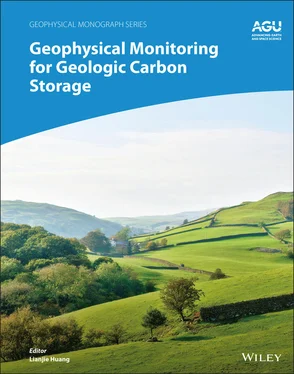Geophysical Monitoring for Geologic Carbon Storage
Здесь есть возможность читать онлайн «Geophysical Monitoring for Geologic Carbon Storage» — ознакомительный отрывок электронной книги совершенно бесплатно, а после прочтения отрывка купить полную версию. В некоторых случаях можно слушать аудио, скачать через торрент в формате fb2 и присутствует краткое содержание. Жанр: unrecognised, на английском языке. Описание произведения, (предисловие) а так же отзывы посетителей доступны на портале библиотеки ЛибКат.
- Название:Geophysical Monitoring for Geologic Carbon Storage
- Автор:
- Жанр:
- Год:неизвестен
- ISBN:нет данных
- Рейтинг книги:4 / 5. Голосов: 1
-
Избранное:Добавить в избранное
- Отзывы:
-
Ваша оценка:
- 80
- 1
- 2
- 3
- 4
- 5
Geophysical Monitoring for Geologic Carbon Storage: краткое содержание, описание и аннотация
Предлагаем к чтению аннотацию, описание, краткое содержание или предисловие (зависит от того, что написал сам автор книги «Geophysical Monitoring for Geologic Carbon Storage»). Если вы не нашли необходимую информацию о книге — напишите в комментариях, мы постараемся отыскать её.
Geophysical Monitoring for Geologic Carbon Storage
Volume highlights include: Geophysical Monitoring for Geologic Carbon Storage
The American Geophysical Union promotes discovery in Earth and space science for the benefit of humanity. Its publications disseminate scientific knowledge and provide resources for researchers, students, and professionals.
Geophysical Monitoring for Geologic Carbon Storage — читать онлайн ознакомительный отрывок
Ниже представлен текст книги, разбитый по страницам. Система сохранения места последней прочитанной страницы, позволяет с удобством читать онлайн бесплатно книгу «Geophysical Monitoring for Geologic Carbon Storage», без необходимости каждый раз заново искать на чём Вы остановились. Поставьте закладку, и сможете в любой момент перейти на страницу, на которой закончили чтение.
Интервал:
Закладка:
Geophysics Group, Los Alamos National Laboratory, Los Alamos, New Mexico, USA
ABSTRACT
Microseismic monitoring can play a crucial role to ensure safe long‐term geological carbon storage. For reliable long‐term monitoring for CO 2‐injection‐induced microseismic events, both a surface seismic array and a borehole geophone array are desired. Optimal design of the seismic network is of great interest to achieve cost‐effective monitoring. We develop a methodology to determine the optimal number of seismic stations with a geometrically satisfactory distribution for given monitoring regions. We design an optimal microseismic monitoring network based on widely accepted guiding principles, and the relationship between the location accuracy of microseismic events and the total number of seismic stations. We determine the optimal number of seismic stations based on the trade‐off curve of the event location accuracy versus the total number of seismic stations. We demonstrate our optimal design method using models from the Kimberlina carbon storage site in California, USA.
4.1. INTRODUCTION
The injection of CO 2into subsurface reservoirs during geological carbon storage changes the stress state of the subsurface through volume and/or mass change, and reduces the effective normal stress by increasing the pore pressure (Ellsworth, 2013). Such changes in stress can induce sudden slip on fractures or faults under certain conditions, generating microseismic events near the target CO 2storage regions. Induced microseismicity associated with the injection of CO 2may cause possible leakage of CO 2or brine from reservoirs along faults, leading to contamination of shallow aquifers. Relatively large induced seismic events may also create public concerns. Microseismic monitoring can play a crucial role to ensure safe long‐term geological carbon storage. Monitoring of induced microseismicity during and after injection operations can help map the movement of CO 2, understand the stress changes in the reservoir, and identify faults and possible leakage pathways (e.g., Maxwell & Urbancic, 2001; Miyazawa et al., 2008; Verdon et al., 2010).
A current microseismic monitoring network includes borehole geophones and surface seismic arrays (e.g., Boullenger et al., 2015; Kaven et al., 2015; Stork et al., 2018). Borehole geophones are more sensitive to small seismic events and surface seismic arrays have better area coverage. The accuracy of microseismic event location depends on the distribution of seismic stations, and thus the optimal design of a seismic network is of great interest to geophysical monitoring. Many previous works on optimal design of a seismic network studied the optimal distribution of seismic stations given a fixed number of total stations using a statistical theory (e.g., Kijko, 1977a,b; Rabinowitz & Steinberg, 1990; Steinberg et al., 1995). Such optimal distribution of surface seismic stations is not necessarily feasible for carbon storage sites considering the permit and geological constraints. In the interest of flexibility and easy adoption by operators, we would like to avoid complicated statistical theory and develop a simple method to study the optimal number of seismic stations for a given geometrically satisfactory network distribution. In other words, we would like to design the seismic network following guidelines based on possible locations of seismic events. Then, we determine the best trade‐off between the event location accuracy and the total number of seismic stations to achieve cost‐effective microseismic monitoring.
The guidelines we follow to design the seismic network distribution are some widely accepted guiding principles based on practical experience and have been provided theoretical basis by some studies (e.g., Chatelain et al., 1980; Kissling, 1988; Gomberg et al., 1990; Rabinowitz & Steinberg, 1990; Husen et al., 2003). Based on these rules, an epicenter can be best located when stations surround it with good azimuthal coverage. A range of station distances is desirable, and the existence of at least one station with small epicentral distance, preferably within about one focal depth, is especially useful for depth determination. The inclusion of S‐wave arrival times besides P‐wave arrival times can improve the hypocenter determination, particularly the depth.
The U.S. Department of Energy (DOE) established the National Risk Assessment Partnership (NRAP) project to develop quantitative risk assessment methodologies for carbon capture, utilization, and storage (CCUS). As part of this initiative, the Kimberlina site in California was proposed as a potential demonstration site. We use the Kimberlina model to demonstrate the application of our optimal design of both surface seismic network and borehole geophone array for microseismic monitoring.
4.2. METHOD
Our method is based on the evaluation of event location accuracy, which provides important parameters and is useful for optimal design of microseismic monitoring (e.g., Eisner et al., 2010; Verdon et al., 2012; Oye et al., 2013; Takagishi et al., 2017; Wuestefeld et al., 2018). We use the following procedures ( Fig. 4.1) for our optimal design of seismic network for cost‐effective microseismic monitoring.

Figure 4.1 The procedure for optimal design of seismic network for microseismic monitoring.
1 Build a velocity model for a field site based on site characterization. The velocity model should be based on previous geology and geophysics studies in this region. When an accurate S‐wave velocity model is not available, the common practice is to assume a constant ratio of V P/V S where V P is the P‐wave velocity and V S is the S‐wave velocity.
2 Define target monitoring regions and generate synthetic microseismic events within target monitoring regions. The target monitoring regions where microseismic events would occur depend on the injection locations, the reservoir depth, and the surrounding geology. The fault that is the closest to the injection site is often of great interest for monitoring. Synthetic true locations of microseismic events may be within reservoirs and/or on faults.
3 Define the distribution region of seismic stations. The range of the area where seismic stations may be distributed depends on the locations and magnitudes of potential microseismic events.
4 Determine the event locations for a given seismic network. First, we calculate the synthetic travel times for P‐waves and S‐waves for all seismic stations using the true locations of microseismic events and the P‐wave and S‐wave velocity models. We add random noise to the calculated travel times, and then use these travel times to solve for the event locations assuming we know the velocity models.
5 Repeat Step 4 for all possible seismic networks. Networks with different seismic stations can be created by varying the spacing of seismic stations.
6 Analyze the relationship between the event location accuracy and the number of seismic stations. The optimal seismic network corresponds to the distribution with the best trade‐off between the event location and the number of seismic stations (or cost).
We demonstrate how to employ these procedures to design an optimal microseismic monitoring network using a synthetic model for the Kimberlina site in California.
4.3. OPTIMAL DESIGN OF A SURFACE SEISMIC ARRAY
4.3.1. Models for the Kimberlina Site
The Kimberlina site is located around the Kimberlina power plant in the southern San Joaquin Valley of California ( Fig. 4.2). The San Joaquin Valley is the southern extension of the elongate Great Valley. Site characterization was performed for this region (Wagoner, 2009; Coblentz et al., 2014). The area has operational oil fields, depleted oil and gas reservoirs, and saline aquifers. The target reservoir is a saline sandstone formation, the Vedder formation, located at a depth of approximately 2,100 m. The Vedder formation is a dipping formation with a thickness of approximately 400 m at the proposed injection location. The overlying low‐permeable Temblor‐Freeman shale provides the caprock. The three major faults at the Kimberlina site are the Greeley Fault, Pond‐Poso Creek Fault, and New Hope Fault. The proposed injection well is located between the Greeley Fault and Pond‐Poso Creek Fault.
Читать дальшеИнтервал:
Закладка:
Похожие книги на «Geophysical Monitoring for Geologic Carbon Storage»
Представляем Вашему вниманию похожие книги на «Geophysical Monitoring for Geologic Carbon Storage» списком для выбора. Мы отобрали схожую по названию и смыслу литературу в надежде предоставить читателям больше вариантов отыскать новые, интересные, ещё непрочитанные произведения.
Обсуждение, отзывы о книге «Geophysical Monitoring for Geologic Carbon Storage» и просто собственные мнения читателей. Оставьте ваши комментарии, напишите, что Вы думаете о произведении, его смысле или главных героях. Укажите что конкретно понравилось, а что нет, и почему Вы так считаете.












